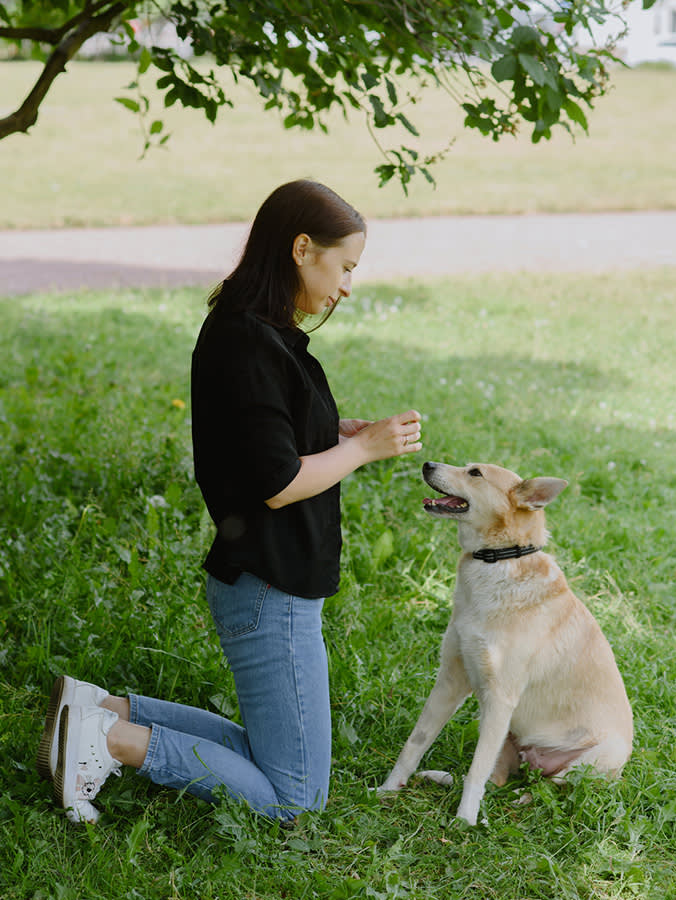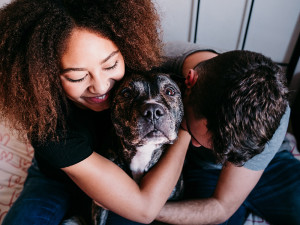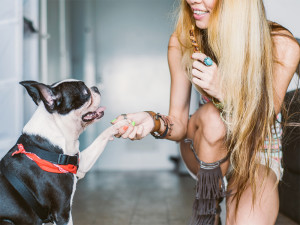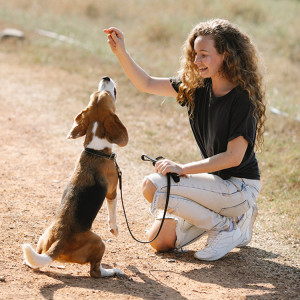How to Make a Comeback After a Dog-Training Fail
Almost all new puppy parents fall at the first hurdle. Here, pro tips on picking yourself up.
Unless you are blessed with beginner’s luck (anyone?), making mistakes when you start a new hobby is not only perfectly normal, it’s also kind of necessary. How else are you going to figure out what went wrong and how to do better? Training your new dog is no different, and snafus along the way — even major fails, let’s be real — are part of the process. Harness all those angsty feels into focusing on a new game plan. Below are some common training mistakes that real pet parents have experienced and my pro tips on how to get back on track.
1. Mixing your messages
When you ask for relationship advice, any seasoned pro will tell you that communication is key. The same goes for your relationship with your pup. You may not speak the same language, but you can effectively communicate with your dog by being consistent. That means giving the same verbal cue every time. For example, if you’re teaching your dog recall, use “come” or “here” but not both; interchanging the commands will only confuse them.
Making sure the whole family is on board with the house rules is essential, too. If you allow your dog on the couch, but your partner doesn’t, your dog will never respect boundaries (and will probably play favorites). Also, do your best to stick to the same schedule on workdays and weekends — if they get special privileges on Sunday, they may act out on other days because they know what they’re missing but not why.
2. Having stage-parent expectations
You went to one training class and taught your dog to shake and sit, so now they’re a gold medalist in your eyes. You might want to manage your expectations. Dogs need lots of repetition and practice in different settings to master new tricks. Get ready to spend at least the first two years working with your dog on core life skills because you’re playing the long game. And even after you’ve got basic obedience in the bag, regularly brush up on commands to avoid backslides and strengthen the bond with your dog.
How much do you spend on your pet per year?
3. Ruling by fear
It’s safe to assume you want to be loved, not feared, by your pup. So, just so we’re on the same page, you already know you should never hurt or yell at your dog, right? Great. In terms of how you want to approach training, positive reinforcement trumps punishment-based methods in long-term studies. They key is rewarding your dog when they do something good, not chastising them when they do something bad.
Rewards can be treats, praise, even playtime — whatever gets that tail going. Reinforcing that good behavior will give it staying power. When they do something bad, which they almost certainly will, redirect them to an appropriate activity. For example, if your pup treats your hand like a teether, immediately pull back and offer them a chew toy. Problem solved, and you won’t have to punish a puppy — which literally no one wants to do.
4. Using the same cue over and over (and over)
When you realize that your cues aren’t quite effective, it’s time to take a step back in the training process. Chances are your pup doesn’t understand what you’re asking, is too distracted, or has become a creature of habit and is waiting for your seventh “sit” to respond. Strip things down by only cueing your dog once, then wait a few seconds to see if they hop to it. (Dogs often need a few seconds to think — again, human language, not their forte.) If you want to speed things up, pair a word with the hand signal you’re teaching; body language is more in their wheelhouse. Remember, without consequence and context, your dog just hears words as sounds coming out of your face.
5. Running marathon training sessions
You may have pulled many an all-nighter in school, but your dog isn’t studying for the bar exam and actually learns more in short spurts. Consider it a dog-training best practice to work on a few cues in two-to-five-minute sessions rather than going the distance — which can bring on frustration, boredom, and loss of focus. After all, it’s about positive associations, and you want to wrap up on a high note while your dog is still enjoying learning. Scheduling a few sessions per day will also force you to take breathers from work (which you keep telling yourself to do, anyway). On that note, remember that you’re training yourself as much as you’re training your dog, so if you find yourself losing patience, table it for another day. If you aren’t having fun, odds are your dog isn’t either.
6. Lining your dog’s path with temptation
Let’s be honest, we are all that person who chooses to order a salad but reaches across the table to eat a friend’s fries. So, expecting your dog to exert more self-control than you can muster is unreasonable. To them, food left out is an all-you-can-eat buffet, an open garbage can is a digging expedition, and shoes are just funny looking chew toys. While you are working on training, it’s worth reminding yourself that human rules don’t make a lick of sense to a dog. Help them help you by managing their environment so they don’t bungle it.
7. Thinking you know best
Props for wanting to train your own dog! It’s an immersive way to learn about dog behavior and communication (while stoking the dog whisperer flame within). As devoted and determined as you are, there’s no shame in calling in reinforcements. If you’re taking two steps forward and three steps back, it’s time to hire a professional trainer, ideally ASAP before a minor bad habit turns into a major behavior issue. From potty training and leash walking to separation anxiety and fear aggression, there’s no reason to go it alone.












